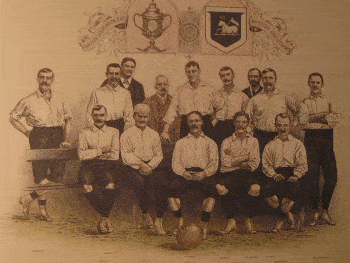Judging the quality of football teams and footballer players who operated prior to the advent of television is notoriously tricky for of course, we have no visual evidence on which to rely. We have to go by the memories of those who can still recall those days, from the books, the newspapers and perhaps the flickering newsreels of the day. Here’s the story of Preston North End.

By Dave Bowler
But if that’s tough, then reckoning on pre-war sides is tougher yet. What about pre-pre-war though? Or the inter-Boer War years? We may not know a huge amount about the way they played, but what we can tell is just who was the best and for a five or six year period from the late 1880s onwards, just as organised football was taking its grip, Preston North End were the boys. After all, they weren’t called the Invincibles for nothing. Even now, after near 50 years of non-achievement in the post Tom Finney years, such was their early success that North End are still rated as the fifth most successful English football club on a domestic level.
Not only that, but they revolutionised the game, pretty much creating professional football in England, taking the game away from the amateurs at the Football Association and the early FA Cup winners such as Wanderers, Old Etonians and the Royal Engineers. When Preston got down to business, they were in it to win it.
Under the leadership of Major William Sudell, they were the Manchester City of their day, swiftly assembling a team of all the talents, happily coughing up the wages and being expelled from the 1884 FA Cup after being accused of “professionalism”. Thirty-six other clubs, largely in the north, protested and so, a year later, the FA recognised the professional game.
Passing Game
Preston’s main hunting ground was Scotland, their team being built around the likes of Nick and Jimmy Ross, Geordie Drummond, David Russell and the legendary John Goodall who, though born in London, learnt the passing game in Scotland after his family moved north. Brought back to England, he was a revelation and the basis of the team that was all but unstoppable.
Their peerless period began in the 1887/88 season. They beat Hyde 26-0 in the first round of the FA Cup, still the competition record, and progressed serenely to the final, beating Bolton Wanderers 9-1, Halliwell 4-0, Aston Villa and Sheffield Wednesday both 3-1 and Crewe Alexandra 4-0. The final at The Oval was against West Bromwich Albion, and so confident were Preston of winning it that they asked the referee if, to save time afterwards when they’d want to be heading home, they could be pictured with the trophy before the game. “Hadn’t you better win it first?” came the reply, and the referee was pretty shrewd in his judgement as Preston lost 2-1.
Football League
But no matter. That humiliation brought the club back to earth and there was a collective realisation that their results were won on performances, not reputations. The inaugural season of the Football League gave Preston the opportunity to show their worth, and they did just that. The best team in the land right from the off, they simply decimated the opposition in the league season that ran from September through to the end of January. The 12 team league saw them play 22 fixtures. They won 18 of them, drew the other four and, in the days of two points for a win, won the title by a massive 11 points and at a stroll, their use of the “Scottish style” weaving rings around the rest.
FA Cup
The league won, it cleared the way for the FA Cup to begin in February. Bootle, Grimsby and Birmingham St George’s were beaten on the way to a meeting with West Bromwich Albion in the semi-finals, where revenge was served cold in the shape of a 1-0 win. It was back to The Oval for the final, against midlands opposition again, but this time there was no arrogance before the game and Wolves were seen off, 3-0, to complete a perfect season – the double and an unbeaten fixture list.
Such dominance required other teams to up their game and many followed the Preston route north to find fresh talent, or simply paid more to rival clubs in England to have the pick of their players. Consequently, the league fight was altogether closer the following year, but Preston retained their title in the end, two points ahead of Everton, but losing four games this time. Signs that the others were catching were also seen in the FA Cup, where they were defeated by Bolton Wanderers in the third round.
Purple Patch
Preston’s purple patch continued over the next three seasons where they were the runners up on each occasion, once to Everton, twice to Sunderland, reaching the FA Cup semi-finals in 1893 where they were beaten by Everton, Sudell losing control of the club in that same year.
The loss of their driving force was significant of course, but in the end, it was the identity of those clubs that gave the biggest clue as to why the Preston era was ultimately doomed. Bigger cities taking a bigger interest in the professional game, pulling in bigger crowds, thereby creating bigger resources and overtaking smaller provincial towns such as Preston. By 1901, North End were struggling to keep up and were relegated from the top flight, caught out by the financial conundrum they’ve been trying to resolve pretty much ever since.